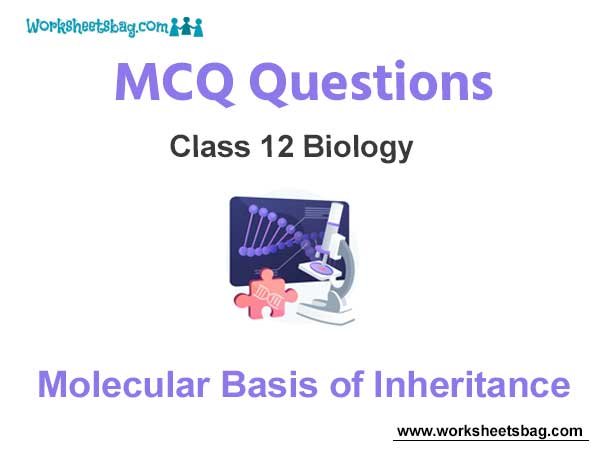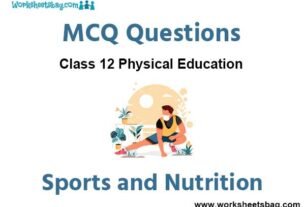Please refer to Molecular Basis of Inheritance MCQ Questions Class 12 Biology below. These MCQ questions for Class 12 Biology with answers have been designed as per the latest NCERT, CBSE books, and syllabus issued for the current academic year. These objective questions for Molecular Basis of Inheritance will help you to prepare for the exams and get more marks.
Molecular Basis of Inheritance MCQ Questions Class 12 Biology
Please see solved MCQ Questions for Principles of Inheritance and Variation in Class 12 Biology. All questions and answers have been prepared by expert faculty of standard 12 based on the latest examination guidelines.
MCQ Questions Class 12 Biology Molecular Basis of Inheritance
Question- In split genes, the coding sequences are called
(a) introns
(b) exons
(c) cistrons
(d) operons
Answer
b
Question- Which of the following RNA polymerase catalyses the formation of transfer RNA in eukaryotes?
(a) RNA polymerase I
(b) RNA polymerase II
(c) RNA polymerase I and II
(d) RNA polymerase III
Answer
d
Question- Hydrogen bonds occur between which of the following constituents of DNA?
(a) sugar and base
(b) phosphate and base
(c) complementary bases
(d) phosphate and sugar
Answer
c
Question- How many pairs nucleotides are present in one turn of DNA helix?
(a) 4
(b) 8
(c) 9
(d) 10
Answer
b
Question- Okazaki fragments are formed during
(a) transcription
(b) translation
(c) replication
(d) transduction
Answer
b
Question- DNA duplication or multiplication is called
(a) transcription
(b) translation
(c) transaction
(d) replication
Answer
d
Question- Watson and Crick proposed the model of DNA structure in
(a) 1943
(b) 1953
(c) 1963
(d) 1965
Answer
d
Question- Part of DNA which switch their positions are called
(a) cistrons
(b) transposons
(c) exons
(d) introns
Answer
b
Question- The terms cistron, recon and muton were proposed by
(a) Benzer
(b) Morgan
(c) Lederberg
(d) Johansen
Answer
b
Question- DNA replication requires
(a) DNA polymerase only
(b) DNA ligase only
(c) RNA polymerase and translocase
(d) DNA polymerase and DNA ligase
Answer
d
Question- Nonsense codon is responsible for
(a) elongation of polypeptide chain
(b) termination of protein synthesis
(c) putting a wrong amino acid
(d) hydrolysis of GTP
Answer
b
Question- Which one is not applicable in respect of genetic code?
(a) Overlapping
(b) Redundancy
(c) Degeneracy
(d) Univers ty
Answer
a
Question- Which of the following sugars is found in RNA?
(a) Hexose
(b) Fructose
(c) Ribose
(d) Glucose
Answer
c
Question- One gene one enzyme hypothesis was proposed by
(a) Jacob and Monod
(b) Watson and Crick
(c) Garrod and Jenson
(d) Beadle and Tatum
Answer
d
Question- Ligase is an enzyme required for
(a) proofreading
(b) joining DNA bits
(c) breaking of DNA
(d) renaturation of DNA
Answer
b
Question- The chain-terminating codon is
(a) AUG
(b) CCC
(c) UAG
(d) GGG
Answer
c
Question- In one strand of DNA the sequence of bases is AAATGGCCCTT, then the complementary sequence of bases on the other side of the strand would be
(a) ATATGGCCCCA
(b) TTTACCGGGAA
(c) TTTTGGCCAM
(d) TTTTGGCCCAA
Answer
b
Question- In bacterial chromosome
(a) there is one origin of replication
(b) there are multiple sites of replication
(c) there is no repair of DNA
(d) replication is very slow
Answer
a
Question- The tryptophan bperon is transcribed
(a) when there is plenty of tryptophan in the cell,
(b) when there is no tryptophan in the cell
(c) when lactose is present
(d) even without RNA polymerase
Answer
d
Question- What is a codon?
(a) agroupofthreedeoxyribonucleotides
(b) a group of three ribonucleotides
(c) a unit of mutation
(d) a group of four ribonucleotides
Answer
b
Question- Viriods differe from viruses in-
(a) Naked DNA molecules
(b) Naked DNA packaged in viral genera
(c) Naked RNA molecules
(d) Naked RNA with protein coat
Answer
c
Question- Out of 64 codons how many of them code for amino acids?
(a) 4
(b) 20
(c) 61
(d) 32
Answer
c
Question- Experimental evidence supporting concept of triplet genetic code was first provided by
(a) Watson
(b) Crick
(c) Michaelis and Menten
(d) Beadle and Tatum
Answer
b
Question- In 1928 Frederick Griffith showed that the hereditary material can pass from one type of bacteria into another through a process called
(a) transduction
(b) invasion
(c) recombination
(d) transformation
Answer
d
Question- The external supply of tryptophan in Escherichia coli brings about
(a) switching on of lac operon
(b) switching off of lac operon
(c) switching on of tryptophan operon
(d) switching off of tryptophan operon
Answer
d
Question- The transforming substance of pneumococcus in Griffith’s experiment was
(a) protein
(b) RNA
(c) DNA
(d) polysaccharide
Answer
c
Question- In 1868 DNA was discovered by the Swedish biochemist
(a) Feulgen
(b) Luria
(c) Mirsky
(d) Friedrich Miescher
Answer
a
Question- The end product of a metabolic pathway may bind a repressor to make the latter active enough to bind to the operator, in which case the end-product is called
(a) inducer
(b) accelerator
(c) corepressor
(d) aporepressor
Answer
c
Question- Enzyme required for transcription is
(a) DNA polymerase
(b) RNA polymerase
(c) RNA-ase
(d) endonuciease
Answer
b
Question- Escherichia co//with completely radioactive DMA was allowed to replicate in nonradioactive medium for two generations. Percentage of bacteria with radioactive DMA is
(a) 12.5%
(b) 25%
(c) 50%
(d) 100%
Answer
c
Question- Synthesis of DNA from RNA template occurs in
(a) reovirus
(b) rous sajcoma virus
(c) T2
(d) TMV
Answer
b
Question- Which one is correct?
(a) DNA replication occurs before mitosis, meiosis and amitosis.
(b) The polarity of DNA template on which leading strand forms is 3′ —» 5′.
(c) The products of gene may be rRNA, tRNA and mRNA.
(d) All of the above
Answer
d
Question- What is the distance between two base pairs in the double helix model of DNA?
(a) 0.34nm
(b) 34nm
(c) 5A°
(d) 10A°
Answer
a
Question- Transcription refers to the
(a) transfer of genetic code or sequences of DNA into RNA
(b) formation of DMA from RNA
(c) formation of protein
(d) polymerisation of RNA in cell-free system
Answer
a
Question- RNA that picks up specific amino acid from amino acid pool of cytoplasm to carry it to ribosome during protein synthesis is
(a) mRNA
(b) tRNA
(c) rRNA
(d) gRNA
Answer
b
Question- The functional unit of gene that specifies synthesis of one polypeptide is
(a) muton
(b) recon
(c) cistron
(d) codon
Answer
d
Question- Information transfer from RNA to DNA is called
(a) replication
(b) reverse transcription
(c) translation
(d) transcription
Answer
b
Question- In operon model, RNA polymerase binds to
(a) structural gene
(b) operator gene
(c) promoter gene
(d) regulator
Answer
c
Question- Which one of the following synthesizes a represser protein?
(a) Regulator gene
(b) Promoter gene
(c) Structural gene
(d) Operator gene
Answer
c
Question- Isotopes used in proving semiconservative replication of DNA were
(a) 14N14C
(b) 14N15N
(c) 14N 31P
(d) 14C31P
Answer
b
Question- Protein coat of a virus in called-
(a) virus
(b) copsid
(c) copsomeres
(d) Cell wall
Answer
b
Question- Generally only one strand of DNA is transcribed. This strand is called
(a) A strand
(b) B strand
(c) sense strand
(d) template strand
Answer
d
Question- Genetic code translates the languagespf
(a) RNA into that of protein
(b) RNA into that of DNA
(c) amino acids into that of RNA
(d) protein into that of DNA
Answer
a
Question- DNA duplex shows
(a) left handed and parallel coiling
(b) left handed and antiparailel coiling
(c) right handed and parallel coiling
(d) right handed and antiparailel coiling
Answer
d
Question- A large cluster of ribosomes is called
(a) megasome
(b) microsome
(c) oligosome
(d) polyribosome
Answer
d
Question- The site of tRNA that binds to mRNA is
(a) codon
(b) anticodon
(c) 5’ end
(d) 3’ end
Answer
b
Question- Triplet codon refers to sequence of three bases oh
(a) tRNA
(b) rRNA
(c) mRNA
(d) alil of these c
Answer
c
Question- Viruses parasiting in bacteria are-
(a) Bacteriophages
(b) Phytophages
(c) Cyanophages
(d) Bacterio-viruses
Answer
b
Question- The difference in A, B and Z forms of DNA lie in
(a) base sequences’
(b) parallelism of chains
(c) hydrogen bonding
(d) internucleotide distances
Answer
d
Question- Reverse transcription was discovered by .
(a) Beadle and Tatum
(b) Watson and Crick
(c) Khorana
(d) Temin and Baltimore
Answer
d


